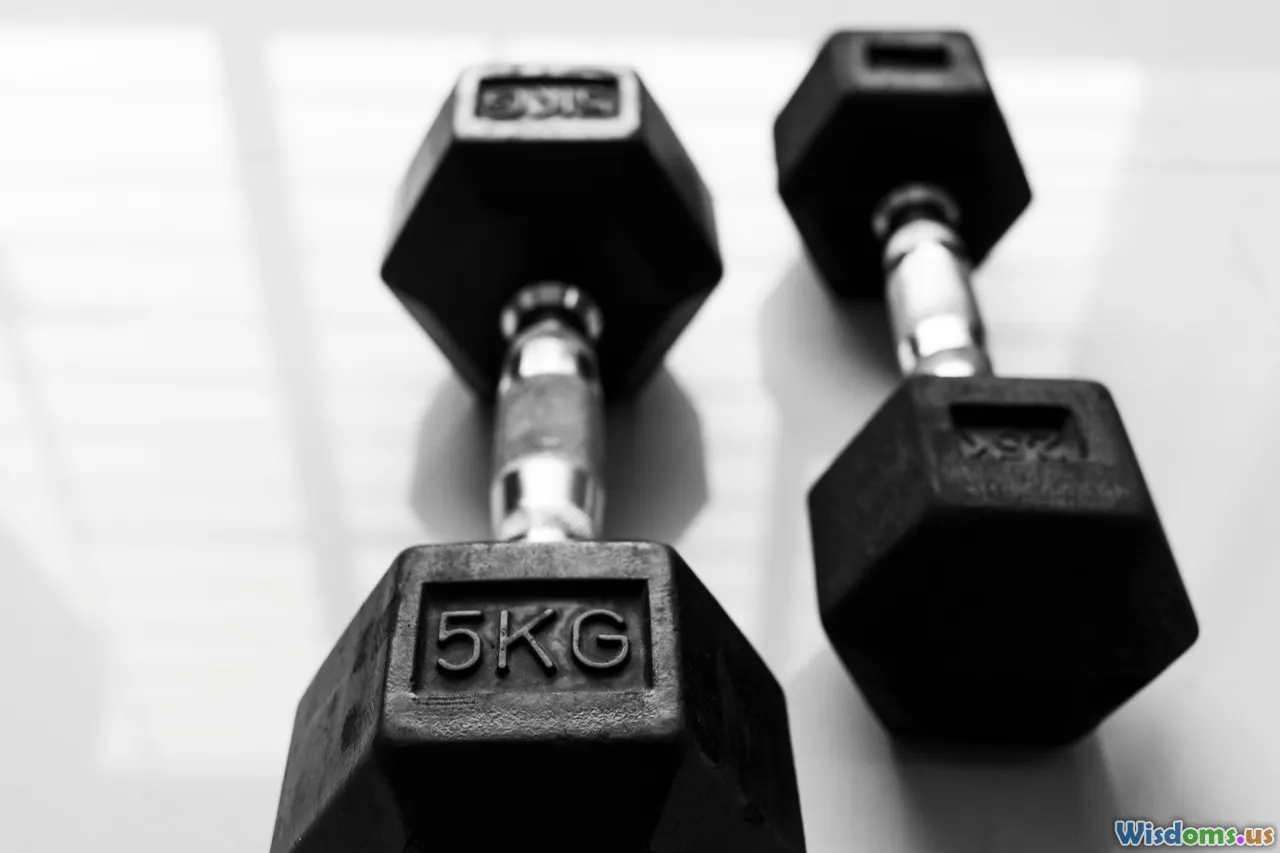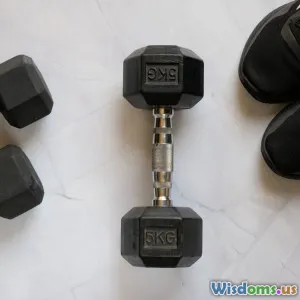
Five Common Mistakes Beginners Make at the Gym
12 min read Discover and avoid the top five mistakes beginners often make at the gym to build safe, effective, and sustainable workout habits. (0 Reviews)
Five Common Mistakes Beginners Make at the Gym
Stepping into a gym for the first time is a bold commitment to personal health and fitness. The air is charged with determination, clangs of weight plates, and the rhythmic whir of treadmills. For beginners, however, this world can be as overwhelming as it is inspiring. Enthusiasm is a powerful motivator, but without the right knowledge, it can lead to costly missteps. To maximize your results and avoid setbacks, let's dive into the five most common mistakes that beginners make at the gym—and, crucially, how to sidestep them with confidence.
Neglecting Proper Warm-Up and Cool-Down

A common misperception among beginners is that workouts start and end with the main routine. Many newcomers dash straight to the treadmill or dive into lifting weights, skipping essential warm-up and cool-down phases. This oversight can not only sabotage performance but also elevate the risk of injury.
Why Warming Up Matters
Warming up prepares your body for the physical demands of exercise by gradually increasing heart rate, circulation, and body temperature. It lubricates the joints, lubricates the muscles, and enhances flexibility—critical factors for optimal performance and injury prevention.
Example: The Five-Minute Dynamic Warm-Up
-
- Leg swings (10 reps per leg)
- Arm circles (forward and backward, 15 seconds each)
- Walking lunges (10 steps)
- Light jumping jacks (30 seconds)
The Role of a Cool-Down
Cool-downs help the body recover by gradually lowering heart rate and promoting circulation, which minimizes dizziness and enhances recovery. Stretching during this phase reduces soreness and maintains muscle elasticity.
Actionable Tip:
Set aside five to ten minutes each for both warm-up and cool-down. All it takes is structured, purposeful movement like dynamic stretches pre-workout and static stretches post-session. Consistency here can pay incredible long-term dividends.
Relying Too Much on Machines

Strength training machines can be inviting for first-timers due to their perceived simplicity and guided movements. While they have a time and a place, an overreliance on machines can stunt overall functional fitness and hinder progress.
Machines: Friend or Foe?
Machines often isolate specific muscles but don't mimic real-life movement patterns. While useful for building basic strength and familiarization, they engage fewer stabilizing muscles than free weights or bodyweight exercises. As a result, crucial muscle groups can remain underdeveloped, and joint coordination may lag.
Example: The Chest Press Conundrum
A chest press machine restricts the movement to one plane, whereas a dumbbell bench press recruits stabilizers in the shoulders and arms, demands core activation, and better translates to practical strength.
Balancing Machines and Functional Moves
- Progress gradually
- Start with some guided machine work if necessary, but introduce free weights and compound movements early in your program.
- Focus on compound exercises
- Exercises like squats, lunges, and push-ups recruit multiple muscles and boost coordination.
Pro Insight:
Ask a trainer to demonstrate proper form for free weight activities. This direct guidance not only deflates the intimidation factor but also prevents form-related injuries.
Copying Others Without a Personal Plan

A newcomer glances around and sees people doing barbell squats or smashing out heavy dumbbell curls. It seems natural to mimic what appears to work—but cookie-cutter routines don’t account for individual needs, fitness levels, and goals.
The Perils of Random Routines
Blindly following the crowd can lead to overtraining some muscles (like arms or chest), neglecting others (back, legs, or core), or even risking injury from improper form or inappropriate workload.
Case Study: The One-Size-Fits-All Error
Jess, a beginner, focused exclusively on upper-body lifts after noticing veterans in the gym prioritized chest and biceps. After a few weeks, Jess developed muscle imbalances and shoulder pain, tracing back to a lack of back and mobility exercises.
Building a Personal Fitness Plan
- Start with your goals
- Is your aim weight loss, muscle gain, improving flexibility, or general health?
- Assess your fitness level
- Beginners should allot lighter loads, moderate volume, and master correct form.
- Document your routine
- Tracking sets, reps, and weights helps track progress and keeps training purposeful.
- Seek professional advice
- Personal trainers or online resources can help you craft an evidence-based regimen tailored to your needs.
Actionable Advice:
Write down your weekly plan before stepping foot in the gym. This strategy keeps your sessions focused, efficient, and aligned with your unique objectives—even if you modify it over time.
Skipping Form Checks and Lifting Too Heavy

Ambition, while admirable, often tempts beginners into lifting more than they can handle or neglecting foundational technique. Poor form isn’t just unproductive; it can lead to nagging injuries that sideline progress for months.
The Risk of „Ego Lifting“
Focusing solely on the amount of weight moved, rather than how it’s moved, undermines muscle development and puts unnecessary strain on the joints and ligaments. For example, squatting with rounded lower back or benching with flared elbows boosts injury risk substantially.
Translation to Real Life: Mary’s Example
Mary (a beginner) rushed to deadlifts and quickly progressed to heavier loads. She soon developed lower back pain due to improper hip alignment and bouncing the bar off the floor. After spending weeks at a physical therapist, she returned, this time prioritizing form even at lower weights.
How to Master Safe Form
- Use mirrors
- They're not just for selfies! They help maintain visual feedback on technique.
- Prioritize control over load
- Master the full range of motion with a manageable weight before considering increases.
- Educate yourself
- Video demonstrations, in-person workshops, or short sessions with a coach bring clarity, instant corrections, and muscle memory reinforcement.
- Record yourself
- Sometimes errors aren’t obvious until seen on video. Many sizable improvements start here.
Action Plan:
Commit to at least once a month checking your form, preferably with an expert. A few corrections now can spare you repetitive strain injuries—and set you up for sustained, injury-free progress.
Neglecting Recovery, Sleep, and Nutrition

The "more is better" mindset has led many beginners to underestimate the importance of recovery, dietary habit changes, and high-quality sleep. Yet, sustainable progress relies as much on what you do outside the gym as within it.
Why Rest and Nutrition Matter
Exercise creates microscopic muscle tears. It's during rest that the body repairs, making muscles stronger and fitter. Sleep supports this anabolic process, aids hormone regulation, and sharpens focus for future workouts. Ignoring these pillars can leave you perpetually fatigued—and potentially staring down burnout.
Facts:
- According to a 2022 study published in the Journal of Sports Sciences, insufficient sleep (less than seven hours per night) can impair strength gains over eight weeks of resistance training.
- Research in Nutrients (2023) found that protein intake post-workout is critical for maximizing muscle repair in beginners.
Actionable Recovery Strategies
- Prioritize Rest Days: Schedule at least 1-2 days off per week to allow tissue repair.
- Opt for quality sleep: Aim for 7–9 hours per night.
- Focus on nutrition: Eat balanced meals, emphasizing lean protein, complex carbohydrates, and nutrient-dense fruits and vegetables.
- Hydrating consistently: Water intake aids every metabolic function, including muscle recovery.
Meal Prep Example:
On Sunday evenings, pre-cook a batch of grilled chicken, quinoa, and roasted vegetables. Store in individual containers for grab-and-go meals that nourish recovery and streamline your busy week.
Practical Tip:
Use a fitness tracker or app to monitor sleep patterns, hydration, and calorie intake. Small, consistent improvements here amplify every workout you do.
Embarking on your fitness journey is an exciting adventure filled with challenges and wins. By avoiding these common beginner mistakes—properly warming up, blending machines with functional training, crafting a tailored plan, prioritizing safe form, and respecting recovery outside the gym—your progress will be smoother and more sustainable. Remember, the gym is a journey rather than a short sprint. Be kind to your body, stay curious, and rejoice in every improvement along the way.
Rate the Post
User Reviews
Other posts in Fitness for Beginners
Popular Posts















